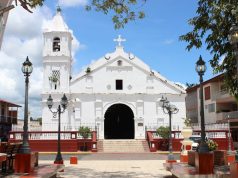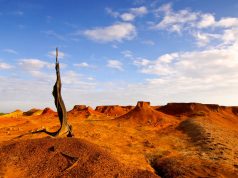Nature and traditions entangle to create the most vibrant experience
It is known as the widest geographical sector in the country and is the largest peninsula in Panama. In it are located the provinces of Herrera and Los Santos in their entirety and a part of the province of Veraguas (southeast). It received this name in memory of the Colombian politician Vicente Azuero in the 19th century, when Panama was part of the Republic of New Granada. In those times it was known as the Azuero Province (1850 – 1855).
In this sector, its roads reveal the prolonged periods of drought in the middle of extensive savannahs, where the agricultural production that fills its inhabitants with pride is perceived. Now, being a part close to the sea, it manages to converge more humid wooded landscapes that invite adventure and beach tourism.
To visit the Azuero Peninsula is to enter the lands of the best makers of the typical luxury and peasant Polleras (traditional skirts); In addition to being home to expert goldsmith craftsmen and accessories to wear along with the most beautiful and representative costumes in the country.
Experts, scholars, historians and folklorists emerge from this love for its roots who continue with the legacy left as a Spanish, native and Colombian heritage in the picturesque towns with colonial feel such as La Arena in Herrera and Las Tablas in Los Santos. This last town is recommended to visit as the main venue for the most famous carnivals in Panama.

Pedasi
This region has been gaining fame for its great waves, which have made it the official venue for national and international surfing tournaments multiple times. Many of its inhabitants are dedicated to agriculture and fishing. Others are closely linked to hospital entrepreneurship, teaching in water sports and related activities.
Among its beaches suitable for extreme sports such as surfing are Playa Venao, Los Destiladores, Playa El Toro and Arenal, to name a few. On the other hand, a destination that stands out for its white sands and paradisiacal turquoise waters is Isla Iguana, at 20 minutes from Pedasi. And yes, it is called that because of the large number of iguanas of all sizes that are always around the island.
Tonosi
Located in the province of Los Santos, is this municipality with a rural environment where most of its population lives in the Tonosi Valley, within the sector of Los Santos Highlands.
It is a town closely associated with Pedasi due to its proximity and fondness for surfing and great fishing. One of the places that the most adventurous seek to visit is the town of Cañas, a coastal community nestled in the Tonosi Valley. This town can be reached by the Macaracas highway, through the Pedasi road, passing Playa Venao and from Las Tablas, through the road that goes to El Cocal and El Carate towns.
It should be noted that the population of Cañas and Isla Cañas are two different places, although close to each other. To visit the town of Isla Cañas, take a boat that will take you to the westernmost side, which is the opposite side of that island.
Azuero Highlands
At Los Santos Province, part of Tonosi is located on the Highlands of Los Santos and borders the district of Las Tablas and Macaracas. There is also Cerro Hoya or Tres Cerros – in the National Park that bears its name – located in the southwest of the peninsula, where the highest point of Azuero is located 1,559 meters above sea level. From its top you can see the Sand Valley (Valle de Arenas) and Coiba island. Other peaks to highlight are La Tronosa hill, Filo de Marroquin, Los Ñopos and Cambutal hill.
In Herrera the Montuoso Forest Reserve has 30,000 acres on the highlands of Herrera, where the basin of the most important river in the Azuero Peninsula, La Villa River, formerly called Cubita River, is preserved. Other important rivers such as El Gato, Tebario, Mariato and Viejo are born from its mountain range. The highest point of this mountain range is the top of Alto El Higo with 986 meters, the highest point of this province.
El Montuoso Forest Reserve
Considered the last refuge of biodiversity in the province of Herrera, El Montuoso Forest Reserve created in 1977, is also known as Azuero’s lung. In its protected area, water sources are preserved in highly pluvial forests, where some wetlands of the La Villa river can be rescued.
It is a suitable place to practice hiking of different difficulties such as camping. Its temperature is very cool, which makes it pleasant to enjoy your stay, especially at night.
This reserve with tropical humid forests has a high potential for endemism. Therefore, you can find endemic and threatened flora species that are protected and studied through international organizations. Among the wildlife that can be seen in the area is the roe deer, white-tailed deer, ñeque, painted rabbit, peacock bass, among other nationally protected species.



Sarigua
Ten minutes from Parita, specifically on the coast of the Gulf of Parita, is located the Sarigua National Park, a unique place in Panama. It is not a desert, although it may seem so due to its cracked and desolate appearance. It is an area that has gone through a process of salinization (salt on the ground), which is why it is called albina. Its name Sarigua comes from the indigenous word salt and water and it has an area of eight thousand hectares.
The traces of erosion are part of the attraction of this place. Despite having little wildlife, it has seen hundreds of types of migratory birds passing through the surrounding mangroves.
The park is divided into three areas: the semi-desert area with 3,500 hectares, the fragmented soil area with 1,500 hectares, and the sea area with 3,000 hectares. In recent years it has been possible to produce shrimp in that marine section, thanks to the intervention of an aquaculture project, and a wind energy project that the Environment Authority (MiAmbiente) has been working on.
To get to Sarigua you must take the road that crosses the towns of Santa Maria and Parita, or by sea. Many of the visitors have made photo sessions such as music videos like the one made by the singer Enrique Iglesias.

Parita
Located in the Herrera Province, it is a colonial town known for being the second settlement of the Spanish in the Azuero Peninsula and the oldest indigenous Hispanic settlement in the Azuerense region. As a curious fact, its name is derived from the word Paris, a nickname that the Spanish gave to the chief Antataura.
Its town preserves the colonial architectural design that today is of great value. It has a square in a park adjoining a church, where it has been used as an agricultural market and in the past was the scene of the buying and selling of black slaves. The Colonial Plaza in Parita has also been a battlefield between two families. At present, the carnival topones (where both opposing sides meet in a fireworks challenge) are celebrated there, typical dances are presented, parades for their saints are celebrated in August, among others.
If you like to visit towns for religious tourism, in Parita you should visit the Church of Santo Domingo de Guzman. A National Historical monument since 1926, this house of prayers has colonial altars, wood sculptures, details worked in baroque style.
This destination keeps its joy with its characteristic drum sound and its playful tunes that make this place a destination to visit at all times.


Things to Do
Go and take a walk through the trails of different types of difficulty of the El Montuoso Forest Reserve in Highlands of Herrera, in the District of Las Minas. Tour the place of origin of La Villa River, in addition to enjoying its pleasant weather. Highly recommended for going and camping. Information: call 974-4256 headquarters of the Tourism Authority in Herrera.
Take on to explore a marine jewel such as Isla Cañas in Los Santos. One of the 11 certified beaches worldwide where sea turtles arrive. There are 14 kilometers of lonely beach to discover. The more than 35,000 turtles come to lay their eggs between June and December. Tourist packages available with the agency Isla Iguana & Isla Cañas Tours in their IG account: ict.experiencias
Learn more about Panama’s diverse nature at the Visitor Center of the Sarigua National Park and you will discover why it is not considered a desert. Hours from 8:00 a.m. to 4:00 p.m. Monday through Sunday. Entrance fee: $4.00 nationals and resident foreigners (over 12 years old), $2.00 retirees, pensioners and the elderly. Foreigners pay $7.00 and children under 12 years old are free. Information: call (507) 6912-5072.
Visit El Cenegon del Mangle in Herrera. This swamp is home to gray herons, cattle egrets and white ibex, as well as numerous migratory birds that nest in this area. This place concentrates the largest number of herons in their nesting stage in the Pacific. It is also an archaeological and healing site for its thermal wells. Information: https://www.miambiente.gob.pa/.
Relax doing horseback riding along the beach while enjoying a stunning sunrise or sunset. Cambutal is famous for its waves highly sought after by surfers. However, it also has relaxing but equally unforgettable activities. Information: info@playacambutal.net.








